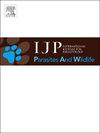Different drivers, same tick: Effect of host traits, habitat, and climate on the infestation of three rodent species by larval Dermacentor ticks
IF 2.2
3区 医学
Q3 ECOLOGY
International Journal for Parasitology-Parasites and Wildlife
Pub Date : 2025-03-07
DOI:10.1016/j.ijppaw.2025.101054
引用次数: 0
Abstract
Tick-borne diseases (TBDs) pose a growing concern for public and wildlife health. Understanding how host traits and environmental factors influence tick infestation in small mammals is critical for improving TBD management strategies. We investigated the presence and load of Dermacentor spp. Larvae on three rodent species: Peromyscus leucopus, Sigmodon hispidus, and Onychomys leucogaster, in the arid brushland ecosystem of South Texas. We used generalized linear models to quantify how host, habitat structure, and climatic variables impact tick presence and load. Our results show that different drivers influenced tick infestation across species; O. leucogaster experienced higher tick loads in smaller individuals and habitats with more leaf litter, whereas for P. leucopus, infestation was determined by the reproductive state and sex of the host as well as larval activity throughout the year. None of the variables measured in this study adequately explained the presence and parasite load in S. hispidus. These findings highlight the importance of considering species-specific interactions between host traits and environmental factors for understanding the dynamics of ticks infestation in rodents. Our results contribute to a growing body of evidence on the complexity of tick-rodent host dynamics and offer insights for predicting changes in parasitism patterns and managing wildlife health in response to a changing environment in South Texas.

不同驱动因素,同一蜱:寄主性状、生境和气候对三种啮齿动物幼蜱侵染的影响
蜱传疾病日益引起公众和野生动物健康的关注。了解宿主特征和环境因素对小型哺乳动物蜱虫侵染的影响,对于改进TBD管理策略至关重要。在美国德克萨斯州南部的干旱灌丛生态系统中,研究了革螨幼虫对三种啮齿动物(白斑大齿鼠、斑纹齿鼠和白斑齿鼠)的孳生情况和孳生量。我们使用广义线性模型来量化宿主、栖息地结构和气候变量如何影响蜱虫的存在和负荷。我们的研究结果表明,不同的驱动因素影响了不同物种的蜱虫侵扰;白腹夜蛾在个体较小和凋落叶较多的生境中具有较高的蜱虫负荷,而白腹夜蛾的侵染是由宿主的生殖状态和性别以及幼虫全年的活动决定的。本研究测量的变量中没有一个能充分解释棘球绦虫的存在和寄生虫载量。这些发现强调了考虑宿主特征和环境因素之间的物种特异性相互作用对于理解蜱在啮齿动物中感染的动态的重要性。我们的研究结果为蜱-啮齿动物宿主动态的复杂性提供了越来越多的证据,并为预测寄生模式的变化和管理野生动物健康以应对南德克萨斯州不断变化的环境提供了见解。
本文章由计算机程序翻译,如有差异,请以英文原文为准。
求助全文
约1分钟内获得全文
求助全文
来源期刊

International Journal for Parasitology-Parasites and Wildlife
Medicine-Infectious Diseases
CiteScore
3.80
自引率
5.60%
发文量
113
审稿时长
45 days
期刊介绍:
The International Journal for Parasitology: Parasites and Wildlife (IJP-PAW) publishes the results of original research on parasites of all wildlife, invertebrate and vertebrate. This includes free-ranging, wild populations, as well as captive wildlife, semi-domesticated species (e.g. reindeer) and farmed populations of recently domesticated or wild-captured species (e.g. cultured fishes). Articles on all aspects of wildlife parasitology are welcomed including taxonomy, biodiversity and distribution, ecology and epidemiology, population biology and host-parasite relationships. The impact of parasites on the health and conservation of wildlife is seen as an important area covered by the journal especially the potential role of environmental factors, for example climate. Also important to the journal is ''one health'' and the nature of interactions between wildlife, people and domestic animals, including disease emergence and zoonoses.
 求助内容:
求助内容: 应助结果提醒方式:
应助结果提醒方式:


